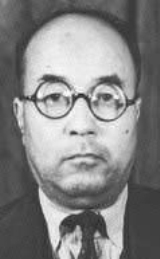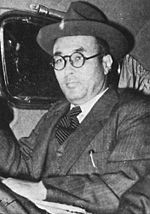
Naoki Hoshino
Encyclopedia

Bureaucrat
A bureaucrat is a member of a bureaucracy and can comprise the administration of any organization of any size, though the term usually connotes someone within an institution of a government or corporation...
and politician who served in the Taishō
Taisho period
The , or Taishō era, is a period in the history of Japan dating from July 30, 1912 to December 25, 1926, coinciding with the reign of the Taishō Emperor. The health of the new emperor was weak, which prompted the shift in political power from the old oligarchic group of elder statesmen to the Diet...
and early Shōwa period
Showa period
The , or Shōwa era, is the period of Japanese history corresponding to the reign of the Shōwa Emperor, Hirohito, from December 25, 1926 through January 7, 1989.The Shōwa period was longer than the reign of any previous Japanese emperor...
Japanese government, and as an official in the Empire of Manchukuo
Manchukuo
Manchukuo or Manshū-koku was a puppet state in Manchuria and eastern Inner Mongolia, governed under a form of constitutional monarchy. The region was the historical homeland of the Manchus, who founded the Qing Empire in China...
.
Biography
Hoshino was born in YokohamaYokohama
is the capital city of Kanagawa Prefecture and the second largest city in Japan by population after Tokyo and most populous municipality of Japan. It lies on Tokyo Bay, south of Tokyo, in the Kantō region of the main island of Honshu...
, where his father was involved in the textile industry
Textile industry
The textile industry is primarily concerned with the production of yarn, and cloth and the subsequent design or manufacture of clothing and their distribution. The raw material may be natural, or synthetic using products of the chemical industry....
. His paternal aunt was principal of the Tsuda College
Tsuda College
is a private women's college in Kodaira, Tokyo. The college was founded in 1900 by Tsuda Umeko as Joshi Eigaku Juku. The name was later changed to Tsuda Eigaku Juku and then Tsuda Juku Senmon Gakko and finally Tsuda Juku Daigaku in 1948....
, a noted women's university.
Hoshino was a graduate of the law school
Law school
A law school is an institution specializing in legal education.- Law degrees :- Canada :...
of Tokyo Imperial University, and on graduation was employed by the Ministry of Finance
Ministry of Finance (Japan)
The ' is one of cabinet-level ministries of the Japanese government. The ministry was once named Ōkura-shō . The Ministry is headed by the Minister of Finance , who is a member of the Cabinet and is typically chosen from members of the Diet by the Prime Minister.The Ministry's origin was back in...
. He rose through the ranks in various capacities, ranging from bank regulation
Bank regulation
Bank regulations are a form of government regulation which subject banks to certain requirements, restrictions and guidelines. This regulatory structure creates transparency between banking institutions and the individuals and corporations with whom they conduct business, among other things...
to taxation, and in 1932, became vice minister of industrial development.
After the establishment of Manchukuo
Manchukuo
Manchukuo or Manshū-koku was a puppet state in Manchuria and eastern Inner Mongolia, governed under a form of constitutional monarchy. The region was the historical homeland of the Manchus, who founded the Qing Empire in China...
in March 1932, Hoshino was invited by the Kwantung Army to lead a team of bureaucrats from the Ministry of Finance to establish a bureaucratic infrastructure to place the finances of the new territory on a sound footing. After 1937, he served as Vice Minister of Financial Affairs in the cabinet of the government of Manchukuo.

Taisei Yokusankai
The was Japan's para-fascist organization created by Prime Minister Fumimaro Konoe on October 12, 1940 to promote the goals of his Shintaisei movement...
in the second Konoe Cabinet
Fumimaro Konoe
Prince was a politician in the Empire of Japan who served as the 34th, 38th and 39th Prime Minister of Japan and founder/leader of the Taisei Yokusankai.- Early life :...
. In 1941, he became a member of the House of Peers
House of Peers (Japan)
The ' was the upper house of the Imperial Diet as mandated under the Constitution of the Empire of Japan ....
and in the same year was appointed Chief Cabinet Secretary
Chief Cabinet Secretary
__notoc__The of Japan is a Minister of State who is responsible for directing the Cabinet Secretariat. The main function of Chief Cabinet Secretary is to coordinate the policies of ministries and agencies in the executive branch...
in the Tōjō administration
Hideki Tōjō
Hideki Tōjō was a general of the Imperial Japanese Army , the leader of the Taisei Yokusankai, and the 40th Prime Minister of Japan during most of World War II, from 17 October 1941 to 22 July 1944...
, and continued his efforts to remold the Japanese economy onto a war economy
War economy
War economy is the term used to describe the contingencies undertaken by the modern state to mobilise its economy for war production. Philippe Le Billon describes a war economy as a "system of producing, mobilising and allocating resources to sustain the violence".Many states increase the degree of...
footing with a state socialist basis.
After the surrender of Japan
Surrender of Japan
The surrender of Japan in 1945 brought hostilities of World War II to a close. By the end of July 1945, the Imperial Japanese Navy was incapable of conducting operations and an Allied invasion of Japan was imminent...
, he was arrested by the American occupation authorities
Supreme Commander of the Allied Powers
Supreme Commander of the Allied Powers was the title held by General Douglas MacArthur during the Occupation of Japan following World War II...
and tried before the International Military Tribunal of the Far East as a Class A war criminal on counts 1, 27, 29, 31, 32. He was found guilty and sentenced to life imprisonment
Life imprisonment
Life imprisonment is a sentence of imprisonment for a serious crime under which the convicted person is to remain in jail for the rest of his or her life...
at Sugamo Prison
Sugamo Prison
Sugamo Prison was located in the district of Ikebukuro, which is now part of the Toshima ward of Tokyo, Japan-History:...
in Tokyo. He was released in 1958.
Subsequently, Hoshino served as president or chairman of a number of companies, including the Tokyu Corporation. He published his memoirs in 1963, which created somewhat of a sensation for his undiminished admiration of Japanese accomplishments in Manchukuo, and his unexpected lack of respect for wartime leader Hideki Tōjō
Hideki Tōjō
Hideki Tōjō was a general of the Imperial Japanese Army , the leader of the Taisei Yokusankai, and the 40th Prime Minister of Japan during most of World War II, from 17 October 1941 to 22 July 1944...
. He died in Tokyo in 1978.

